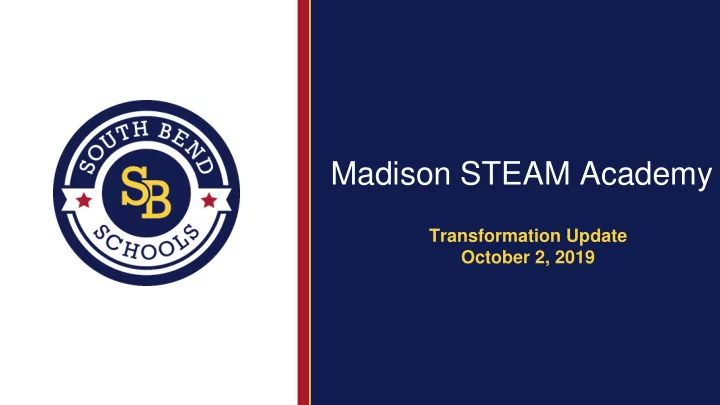

Madison STEAM Academy Transformation Update October 2, 2019
TEAM South Bend Dr. Todd Cummings- Superintendent Ms. Deb Martin- Madison STEAM Academy Principal Ms. Cynthia Werntz- Literacy Specialist Ms. Jennifer Arzola-Instructional Leader Director
Visual Thinking Strategies FOR BOTH TEACHERS AND STUDENTS Used as strategy in all focus areas
Focus on Change
School Improvement Goals ● Focus Area 1- Foundational Reading Skills ● Focus Area 2- Reading Comprehension ● Focus Area 3- Math ● Focus Area 4-Attendance ● Focus Area 5- ELL WIDA
Reset of Performance Benchmarks 2019 Year 5 ‘ 23 Year 2 ELA: A: 6.5% ‘ 20 Math th: 10.4 .4% ELA: A: ≥ 70.0% 0% Math: h: ≥ 70.0% 0% ‘19 ELA: A: ≥ 45.0 .0% Math: h: ≥ 40.0 .0% Baseline ‘18 ELA: A: 34.4% .4% Math: h: 28.3 .3% **State transitioned from ISTEP+ Assessment to ILearn in Spring 2019
mClass Dibels - Kindergarten 2015-2019
Focus Area 1- Foundational Reading Skills Foundational Skills Reading Goal: Increase the percentage of K-2 Madison students proficient in key phonics reading skills. Growth Goals: K-2 Dibels Composite Score Year 1 will be 15% Year 2 will grow 10% Year 3 will grow 8% Measurement Tool: mClass Amplify Calculations: Completed using gap analysis and 2019 EOY scores
Focus Area 1-Targeted Interventions ● Wilson Fundations Systematic Approach to Literacy ● Professional Development for Tier I and Tier II Staff ● Identify bottom 25% and establish Title 1 and Tier II interventions in K-1 focused on target skills ● Focused data meetings on Foundational Skills and Progress ● Shared teacher, school, and district improvement goals ● District Level Support through Literacy Coordinator
ELA ISTEP+ DATA 2014-2018 AND ILEARN 2019
NWEA Summary Reading Growth 2019
Focus Area 2- Reading Comprehension Comprehension Reading Goal: Increase the percentage of Madison students meeting their NWEA Reading Growth Goal by grade as measured by the NWEA Achievement Status and Growth Summary Report. Increase per grade from 2018 EOY growth scores as measured by NWEA. Growth Goals: K-5 NWEA Growth Goals by Grade Kindergarten- 15% year 1, 15% year 2, 10% Year 3 1st Grade-15% year 1, 15% year 2, 10% year 3 2nd Grade -14% year 1, 10% year 2, 10% year 3 3rd Grade- 13% year 1, 10% year 2, 10% year 3 4th Grade-13% year 1, 10% year 2, 10% year 3 5th Grade- 15% year 1, 10% year 2, 10% year 3 Measurement Tool: NWEA Achievement Status and Growth Summary Report Calculations: Completed using gap analysis and 2019 EOY scores
Focus Area 2-Targeted Interventions ● Whole School Focus on Comprehension ● Professional Development for Tier I and Tier II staff ○ Literacy Coaching in Classroom ○ Visual Thinking Strategies ○ Comprehension Connections ○ Picture Perfect Science ○ Social Emotional Learning ● Focused data meetings on Comprehension ● iRead3 targeted interventions all 3rd grade students 30 minute per day ● Shared teacher, school, and district improvement goals ● District Level Support through Literacy Coordinator
MATH ISTEP+ DATA 2014-2018 AND ILEARN 2019
NWEA Summary Math Growth 2019
Focus Area 3- K-5 Math Math Goal: Increase the percentage of Madison Students meeting their NWEA Math Growth Goal by grade as measured by the Achievement Status and Growth Summary Report . Growth Goals: K-5 NWEA Growth Goals by Grade Kindergarten- 12% year 1, 10% year 2, 9% year 3 1st Grade-12% year 1, 10% year 2, 3% year 3 2nd Grade -12% year 1, 10% year 2, 4% year 4 3rd Grade- 12% year 1, 10% year 2, 10% year 3 4th Grade-15% year 1, 15% year 2, 10% year 3 5th Grade- 15% year 1, 15% year 2, 10% year 3 Measurement Tool: NWEA Achievement Status and Growth Summary Report Calculations: Completed using gap analysis and 2019 EOY scores
Focus Area 3-Targeted Interventions ● Whole School Focus on Math Growth in Number Sense ● Professional Development for Tier I and Tier II Staff ● Math Coaching in Classroom ● Identify bottom 25% for targeted Title 1 and Tier I interventions in K-1 ● Focused instruction and interventions on target skills in number sense ● Focused math data meetings ● Shared teacher, school, and district improvement goals
Student Attendance
Focus Area 4-Attendance Attendance Goal: ● Increase student attendance to 97%, a 6% increase from previous data points. ● Decrease time student is out of classroom using new strategies for working with kids in trauma Measurement Tool: Powerschool information system Calculations: Goal set at state expectation .
Focus Area 4-Targeted Interventions ● Closely monitor attendance and tardies for identified lowest quartile of absentee students ● Teacher call home when an identified student is absent ● Administrative Assistant monitoring of at-risk students and tracking ● FaccS communication with parents on the importance of attendance both in written and during home visits. ● Social Emotional Learning- staff training will reduce negative behavior
Average WIDA Growth by Skill
Average WIDA Growth Grade Level
Focus Area 5- ELL WIDA Growth WIDA Goal: EL students will meet their expected yearly progress toward English language proficiency. Yearly progress is determined by the students’ initial access score. ● Exit Criteria: Students must reach an overall composite score of 4.8 or higher with at least a 4.0 on the reading and writing domains. Measurement Tool: WIDA assessment for EL students Calculations: Completed using students’ initial WIDA scores and calculated individually based on those scores using table 8.
Focus Area 5-Targeted Interventions ● Professional Development from district Bilingual Department on strategies to increase WIDA writing/speaking growth among all students ● Increase knowledge of Finish Line to all classroom teachers to help improve speaking and writing skills ● Use of Visual Thinking Strategies to improve speaking and writing among all students (District Literacy Coordinator) ● Train EL teachers how to use Elevation data to improve students’ growth ● Model Comprehension and Writing using concrete methods to improve student understanding (Comprehension Connections Schoolwide program)
Questions?
Recommend
More recommend